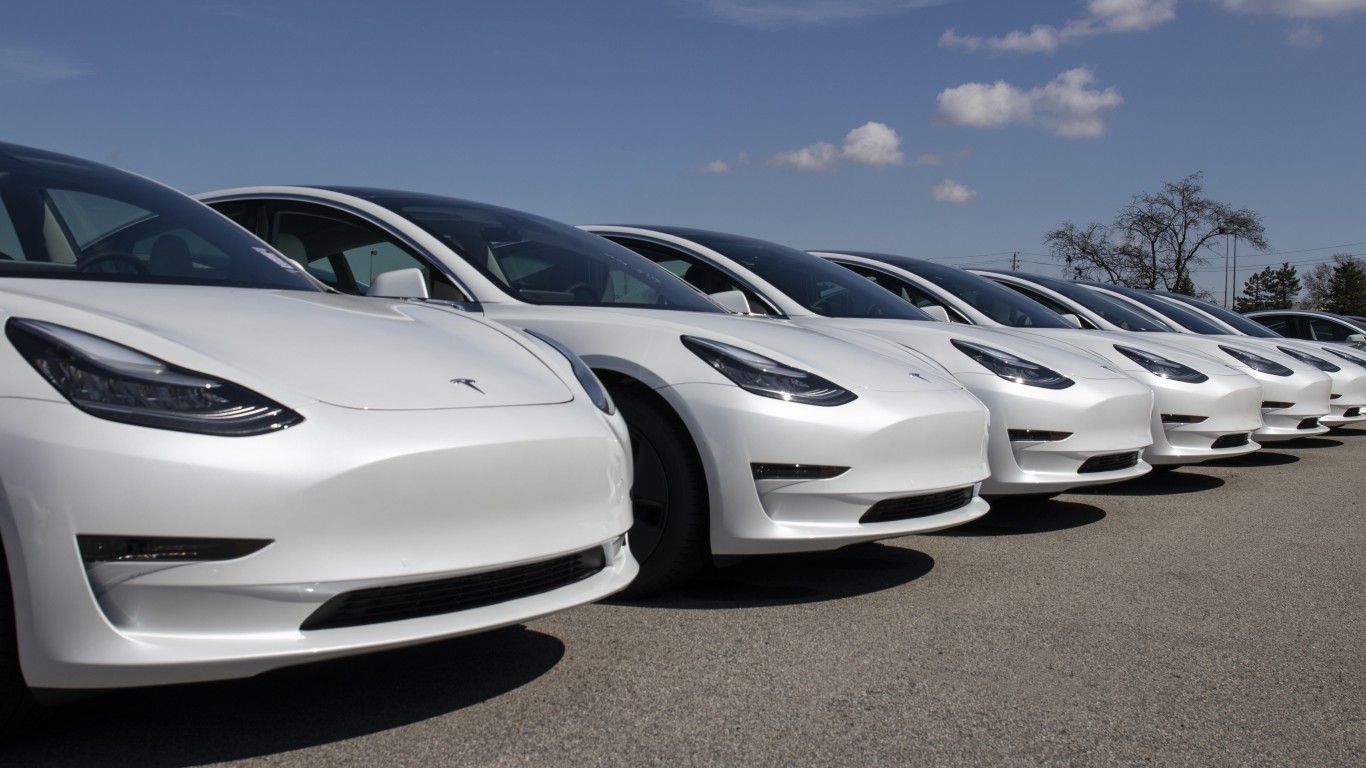 The most successful car in history may be the Ford Model T. While other models may have sold more vehicles, Ford managed to sell nearly 17 million cars from 1908 to 1927 — a period when car ownership was rare compared to today. The Model T was so successful that nearly every other best-selling car adopted its formula. The Model T was inexpensive to buy, inexpensive to operate, reliable and built by a large company that had hundreds of dealerships and trained mechanics. The other vehicles on this list, from the VW Passat to the Toyota Corolla, share all of these characteristics. The best-selling cars through history have appealed to a broad buyer base because they are within the reach of the masses.
The most successful car in history may be the Ford Model T. While other models may have sold more vehicles, Ford managed to sell nearly 17 million cars from 1908 to 1927 — a period when car ownership was rare compared to today. The Model T was so successful that nearly every other best-selling car adopted its formula. The Model T was inexpensive to buy, inexpensive to operate, reliable and built by a large company that had hundreds of dealerships and trained mechanics. The other vehicles on this list, from the VW Passat to the Toyota Corolla, share all of these characteristics. The best-selling cars through history have appealed to a broad buyer base because they are within the reach of the masses.
Read The Best-Selling Cars of All Time
The best-selling vehicles have several other notable features in common. For one, the majority were introduced just before or around the same time that gas prices began to rise rapidly in the early 1970s, primarily because of the Arab oil embargo. Car companies offered 4-cylinder, light and fuel-efficient cars that allowed people to drive without badly hurting household budgets. Many of these cars continue to sell well today as gas prices are relatively high around the world.
Many of these cars also are manufactured and sold around the world. The Beetle is sold in the U.S. and Europe. The Passat is built in both the U.S. and China. Several of the best-selling cars from Japan are sold in most major countries around the world. Once a car proved its appeal with consumers, it made economic sense for a manufacturer to use the same base chassis and engine at plants on different continents.
24/7 Wall St. looked at best-selling car data from a number of sources. The sources included major media outlets that cover the auto industry, research firms, and car companies that keep lists of their own best-selling cars.
This is the 24/7 Wall St.’s Best Selling Cars of All Time.
10. Chevy Impala (1958 – )
> Sales: 14 million
> Parent: General Motors (NYSE: GM)
> Price: $25,760 (most recent)
> Type: mid-priced V6 coupe
GM, the world’s largest car company, only has one vehicle on the list of the best-selling cars in history. That is probably because GM is a holding company with a number of brands. The Impala is also unique on the list because it is a fairly large 2-door coupe. It was even built with a huge 8-cylinder engine for a period, which made it the equivalent of many sports cars. In the early 1960s, Chevy added a 4-door model to increase the appeal of the vehicle to people who wanted a roomier backseat. The versatility of the Impala was broadened when most early models came in both hardtop and convertible. The car has been through 10 generations of major upgrades. The most recent will be offered as a 2014 model. The 2-door version of the Impala, which was the only model of its first generation, is gone.
Also Read: Eight Industries the U.S. Has Lost to China
9. Passat (1973 – )
> Sales: 15.5 million
> Parent: Volkswagen
> Price: $19,995 (most recent)
> Type: mid-priced 5 cylinder 4 door
The Passat has a 5-cylinder engine, rare among cars. It provides relatively good fuel mileage along with moderate acceleration. The Passat is priced just above the Jetta sedan and below the VW CC turbo sedan. The Passat is an unusual car because the product sold in the U.S. is very similar to the one sold by Shanghai Volkswagen Automotive in China, the world’s largest car market. VW has placed a great deal of its emphasis on the Passat, hoping it would help it grow its modest U.S. sales. The car competes with a number of mid-sized sedans sold by the Big Three and major Japanese manufacturers. VW understands that the sale of sedans, which can be used by both individual drivers and families, is critical if it is to enlarge its market share.
8. Model T (1908 – 1927)
> Sales: 16.5 million
> Parent: Ford
> Price: $260 (1920s)
> Type: first mass-production sedan
The Model T is as well known for what it did for American manufacturing as what it did for American consumers. Henry Ford created the modern assembly line to make the Model T. The demand for the car, which was inexpensive by early 20th century standards, spurred Ford’s founder to set up a factory system so cars could move from one workstation to the next with a worker at each station adding one major part to the car. The assembly line allowed Ford to employ thousands of people in its Detroit area factories at relatively high wages. The other major effect of the Model T is that it made car owners out of millions of Americans. The early versions of the car sold for well under $1,000, later versions sold for under $300.
Also Read: Ten States With the Worst Mortgage Debt
7. Accord (1976 – )
> Sales: 17.5 million
> Parent: Honda
> Price: $21,380 (most recent)
> Type: inexpensive 4 cylinder mid-sized sedan
The Accord is Honda’s mid-sized car. It is larger and more expensive than the Civic, but less expensive than the Japanese car company’s line of crossovers and hybrids. The Accord benefited from the rise in oil and gas prices in the early 1970s. It was first sold in Japan and then imported to the U.S. It was one of the first Japanese cars built in the America, beginning in 1981. The car has been so successful that it has gone through nine generations of upgrades and changes, the most recent for the 2013 model year. The base car of each generation has had a 4-cylinder engine at, or under, 2 liters to ensure fuel efficiency. Like many of the least expensive sedans sold by all of the major car companies, the Accord can be purchased with a number of options and even an upgraded 6-cylinder engine for more power and acceleration. The top-of-the-line Accord has a base price of nearly $30,000.
6. Civic (1972 – )
> Sales: 18.5 million
> Parent: Honda (NYSE: HMC)
> Price: $15,605 (most recent)
> Type: inexpensive 4-cylinder sedan
Before the Civic’s 1972 debut, Honda was primarily known for its motorcycles. The car is now one of the most popular models in America. The Civic is Honda’s low-end, light-weight, fuel-efficient offering. The base model sells for only $15,605, gets 39 MPG on the highway, and has a 4-cylinder engine. Honda offers customers of the Civic a large number of features, which can increase the price of the car. But Honda keeps a common platform to save money. There are currently hybrid models of the car, and one that operates on natural gas. The natural gas version, with a few options, sells for more than $30,000. The Civic is another example of a tiny, fuel-efficient car that gained sales traction in the U.S. when fuel prices soared in the early 1970s. The basic car has been modified and substantially upgraded nine times since the first Civic came off the assembly line.
5. Escort (1968 – 2000)
> Sales: 20 million
> Parent: Ford
> Price: $11,950 (2000)
> Type: inexpensive 4-cylinder 2-door/4-door
The Escort was a small, fuel-efficient car introduced in England in 1967 and then throughout much of Europe over the following two years. The vehicle was Ford’s answer to the army of small cars made by European manufacturers like Fiat, Renault and VW. All were meant to use little gas and be cheap to operate. Most Escorts have small engines of less than 2 liters. This was enough to power 2-door, 3-door and 4-door versions of the car in a region in which gas is usually very expensive. There were six generations of Escorts. Each version offered more options and larger engines than the one before it. The Escort was replaced by the Ford Focus. A car called the Escort was sold in the U.S. from 1981 to 2003, but its great success was in Europe. That new car, sold in the U.S., unrelated in its design, is not counted here.
Also Read: The Nine American Cities Nearly Destroyed by the Recession
4. Beetle (1933 – )
> Sales: 23.5 million through 2011
> Parent: Volkswagen
> Price: $19,795 (most recent)
> Type: inexpensive rear-engine 4-cylinder
The Beetle is VW’s flagship. Launched eight decades ago, following orders by Adolf Hitler for a family-sized “people’s car,” it was designed by sports car enthusiast Ferdinand Porsche. The vehicle has changed very little since the 1940s. It is unusual among economy cars because its engine is in its rear and is air cooled. The Beetle also comes with a diesel engine, which is a rarity among passenger cars. New diesel engines get mileage similar to hybrids. The current version of the Beetle sold in the U.S. has a small 2.5 liter, 4-cylinder engine and sells for under $20,000. To appeal to more upscale buyers and those who want better engine performance, VW offers a Turbo-powered model for nearly $30,000. VW must regret it did not market the Beetle more aggressively in the U.S. when it was among the best-selling small cars in the U.S. Japanese models and a move by the Big Three to offer fuel-efficient vehicles pushed the Beetle nearly out of the U.S. market.
3. Golf (1974 – )
> Sales: 27.5 million
> Parent: Volkswagen
> Price: $17,995 (most recent)
> Type: inexpensive 4-cylinder sedan
The Golf is VW’s least expensive compact car. When it debuted in 1974, it was originally called the Rabbit in America, and was intended to be the Beetle’s successor. Like several of the other cars on this list, it is built to be within the budgets of millions of people, as well as inexpensive to operate after purchase. The popularity of the Golf, Beetle and Passat has helped drive VW to the number two car manufacturer in the world for 2011. The Golf sells for less than $18,000 in the U.S. The base model is a 2-door with a 4-cylinder, 2.5 liter engine. VW still lags every major global manufacturer in U.S. sales. It has counted on the Golf to help close that gap. But last year it only sold 324,000 cars (all models) in the U.S., which gave it a 2.2% market share — a disappointing performance for a multinational that sold over 8.1 million vehicles worldwide.
2. F-Series (1948 – )
> Sales: 35 million
> Parent: Ford (NYSE: F)
> Price: $22,990 (most recent)
> Type: Pickup
The F-Series has been America’s best-selling full-body pickup for more than 30 years. It certainly has faced significant competition over the years, especially from the Dodge Ram, Chevy Silverado and GM Sierra, which are all built by Chrysler and GM. More recently, other competitors entered the market, such as Honda with its Ridgeline, Toyota with its Tundra, and Nissan with its Titan. But none has been able to drop the F-Series from its spot at the top of the pickup market. One of the strengths of the F-Series is that it comes in so many models that have a broad appeal across a wide set of customers. The base F-150 costs less than $23,000. Larger models are used in the construction and farm business. These have engines with outputs of well over 300 horsepower and dual rear tires. The F-450 Super Duty King Ranch has a sticker price of $63,615.
Also Read: The Most Innovative Companies in the World
1. Corolla (1966 – )
> Sales: 37.5 million
> Parent: Toyota (NYSE: TM)
> Price: $16,130 (most recent)
> Type: inexpensive 4-cylinder sedan
The Corolla has been the flagship of the world’s third-largest car company for more than four decades. The car has gone through 10 generations of model upgrades. It was the perfect car for Japan when it was introduced — small and fuel efficient. It was a perfect car for America when oil and gas prices soared and then fluctuated after the early 1970s oil embargo. The car always has been outfitted with a small 4-cylinder engine. The current base motor output is 132 horsepower and gets as much as 35 MPG. Ironically, an even more fuel-efficient car — the Toyota Prius hybrid — outsold the Corolla in Japan in 2010.
Douglas A. McIntyre
Get Ready To Retire (Sponsored)
Start by taking a quick retirement quiz from SmartAsset that will match you with up to 3 financial advisors that serve your area and beyond in 5 minutes, or less.
Each advisor has been vetted by SmartAsset and is held to a fiduciary standard to act in your best interests.
Here’s how it works:
1. Answer SmartAsset advisor match quiz
2. Review your pre-screened matches at your leisure. Check out the advisors’ profiles.
3. Speak with advisors at no cost to you. Have an introductory call on the phone or introduction in person and choose whom to work with in the future
Get started right here.
Thank you for reading! Have some feedback for us?
Contact the 24/7 Wall St. editorial team.



